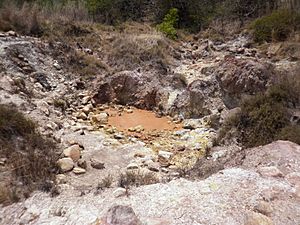Los Ausoles facts for kids
Los Ausoles is a special place in El Salvador where you can find many hot springs. It's about 20 kilometers (12 miles) north of a city called Ahuachapán. This area is so active with heat from the Earth that some people call it the "capital of Central American geothermal activity."
Geothermal activity means heat coming from deep inside the Earth. This heat warms up water underground, which then bubbles up to the surface as hot springs.
Contents
Discovering Los Ausoles: El Salvador's Steaming Hot Springs
Many of the springs at Los Ausoles create a lot of steam, like giant natural saunas! Imagine seeing thick clouds of steam rising from the ground. Back in 1850, people described these springs as a "semi-fluid mass of mud and water." This mud and water was boiling, constantly throwing big bubbles to the surface. The hot mud could be black, red, or even a yellowish-brown color. It's like a giant, bubbling cauldron made by nature!
What Makes Hot Springs So Hot?
Hot springs are heated by magma (molten rock) deep within the Earth. When rainwater seeps into the ground, it gets warmed up by this magma. The hot water then rises back to the surface through cracks in the rocks, creating these amazing hot springs. Sometimes, the water is so hot it turns into steam or causes mud to bubble.
The Five Main Springs of Los Ausoles
While there are many hot spots in Los Ausoles, five main springs are the most famous. Each one has its own unique features:
El Zapote
El Zapote is a large, round crater about 20 meters (65 feet) wide. A crater is a bowl-shaped hole, often formed by volcanic activity. This one is filled with hot, bubbling water.
Valdivieso
Valdivieso is another spring about 20 meters (65 feet) wide. It has four different openings where the hot water comes out. It's special because its water is known for its beautiful blue color, which comes from sulfur. Sulfur is a natural element that can give off a distinct smell, often like rotten eggs.
El Barreal
El Barreal is different because it's mostly made up of mud ponds. These ponds are filled with hot, bubbling mud instead of clear water. It's a fascinating sight to see the thick mud churning and gurgling.
La Labor
La Labor is the largest of the main springs, stretching about 200 meters (650 feet) across. It has seven openings that produce strong smells and loud noises. Here, you can also see clay and mud geysers. A geyser is a hot spring that shoots a column of hot water and steam into the air, like a natural fountain!
El Salitre
El Salitre is a hot water lagoon. A lagoon is a shallow body of water, often separated from a larger body of water. This lagoon is filled with warm water, making it a unique natural pool.
See also
 In Spanish: Los Ausoles para niños
In Spanish: Los Ausoles para niños


